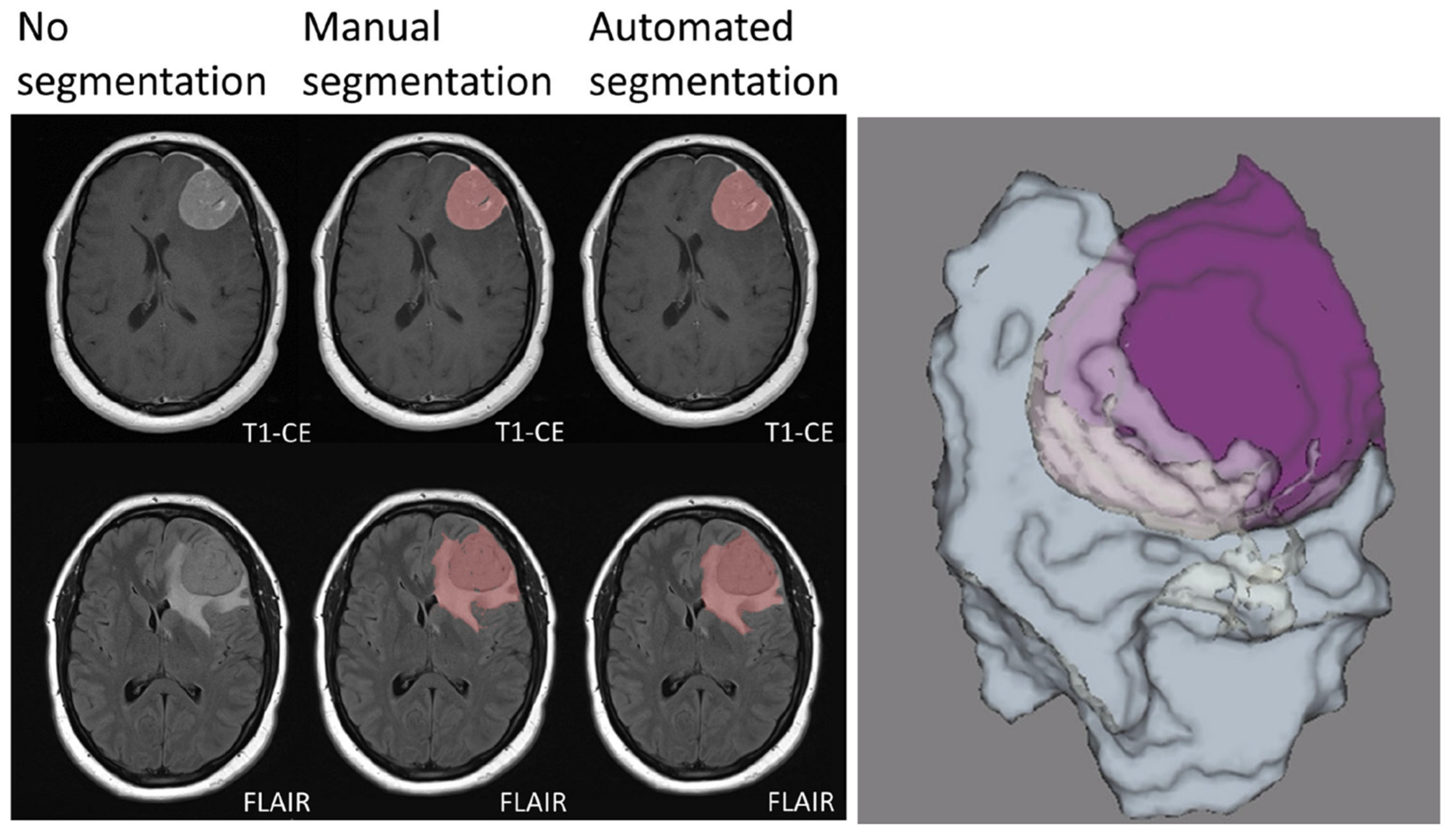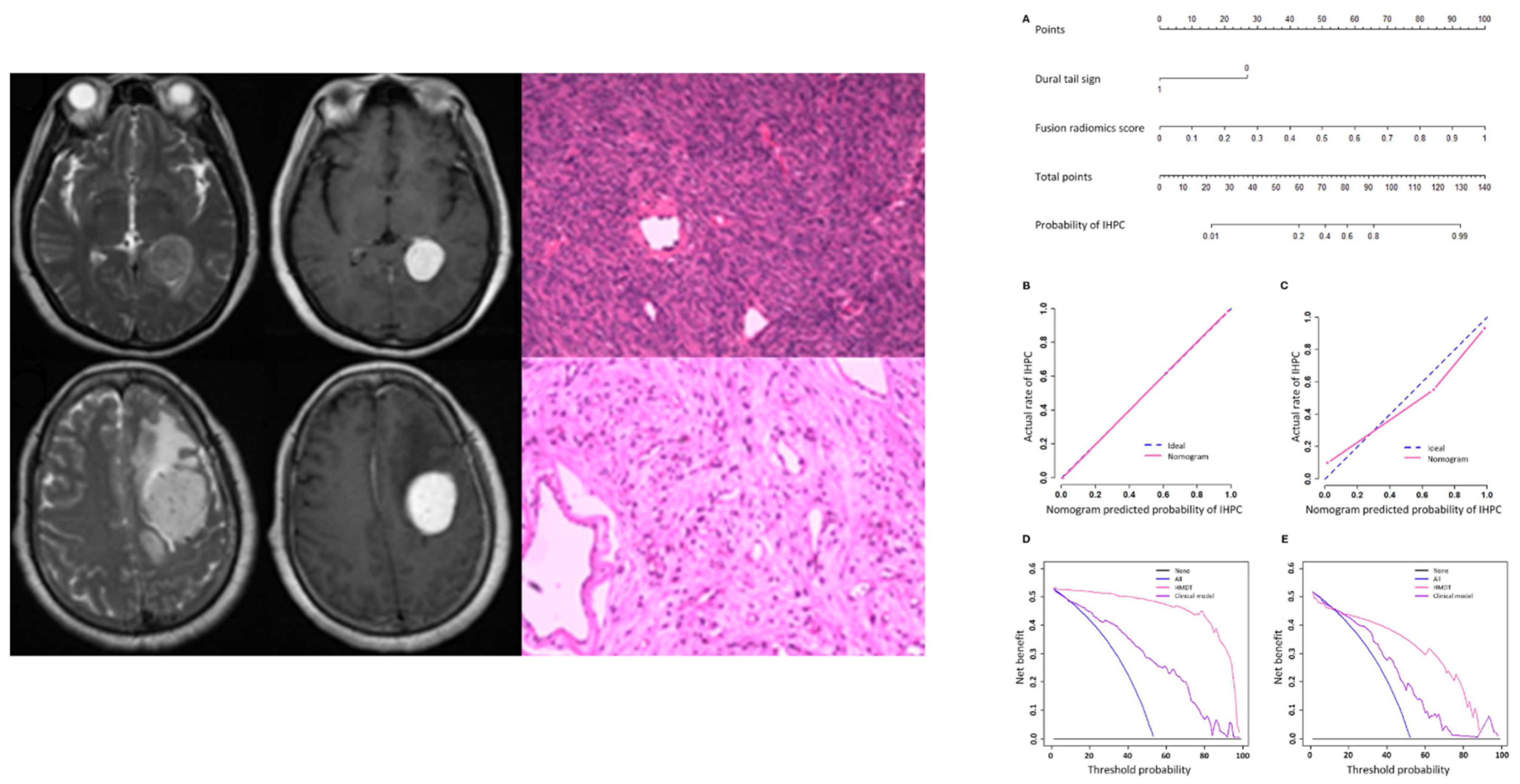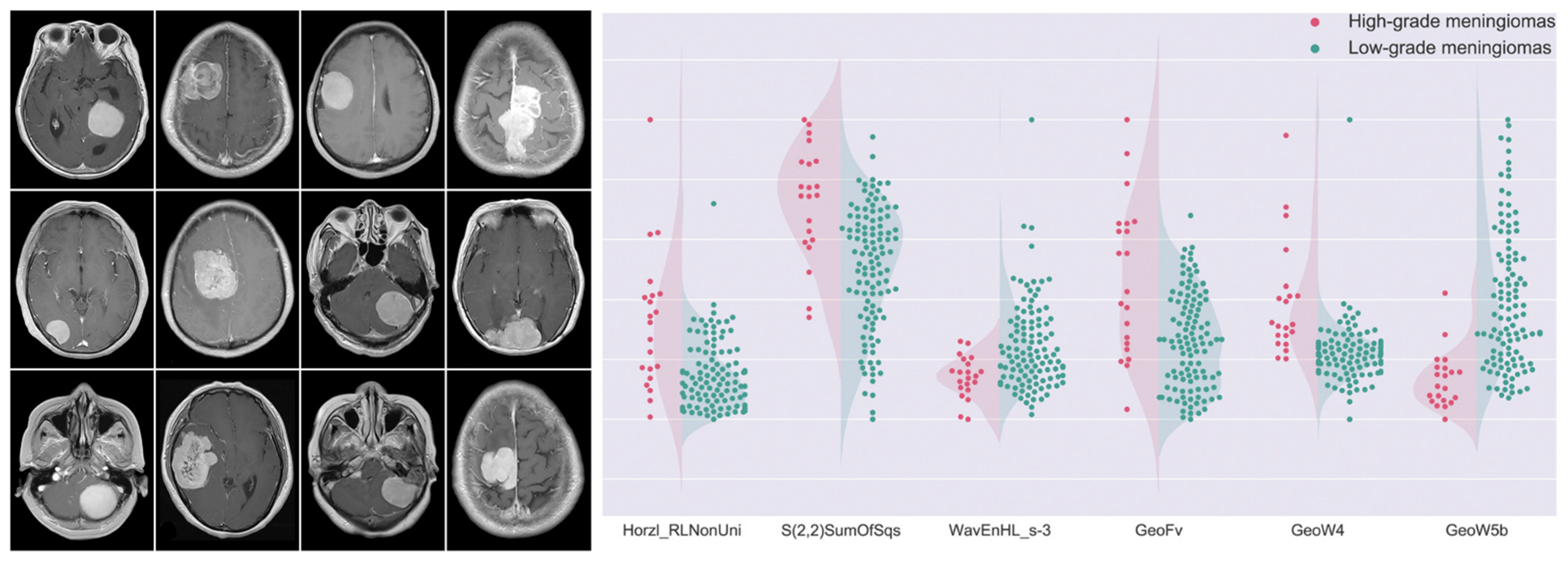Meningioma Radiomics: At the Nexus of Imaging, Pathology and Biomolecular Characterization
Abstract
:Simple Summary
Abstract
1. Background
2. Radiomics and Artificial Intelligence
- Supervised learning: the algorithm input is provided as a labeled training dataset (ground truth); this is the most commonly employed technique in medical imaging. Supervised learning includes classification and regression algorithms. Classification algorithms aim to assign specific categories to new data instances. Linear classifiers, support vector machines, decision trees, and ensemble methods (e.g., random forest) are common types of classification algorithms. On the other hand, regression algorithms attempt to estimate the mapping function from input variables to continuous output variables.
- Unsupervised learning: the algorithm explores the underlying patterns and predicts the output without a labeled database; for this reason, the post hoc interpretation of the resulting clusters may be very complex, and a large amount of training data is usually required.
- Reinforcement learning: based on feedback loops (negative and/or positive reinforcement) and requires a trial–error process. This approach has been commonly applied in robotics, telecommunications, and game theory fields.
3. Lesion Segmentation
4. Differential Diagnosis
5. Tumor Consistency
6. Grading
- Increased cellularity;
- Small cells with high N/C ratio;
- Large and prominent nucleoli;
- Patternless or sheet-like growth;
- Foci of “spontaneous” or geographic necrosis.
7. Prediction of Progression and Recurrence
8. Prediction of Radiosurgery Response
9. Limitations
10. Conclusions
Author Contributions
Funding
Conflicts of Interest
References
- Walsh, K.M. Epidemiology of meningiomas. In Handbook of Clinical Neurology; Elsevier: Amsterdam, The Netherlands, 2020; pp. 3–15. [Google Scholar]
- Louis, D.N.; Perry, A.; Reifenberger, G.; von Deimling, A.; Figarella-Branger, D.; Cavenee, W.K.; Ohgaki, H.; Wiestler, O.D.; Kleihues, P.; Ellison, D.W. The 2016 World Health Organization Classification of Tumors of the Central Nervous System: A summary. Acta Neuropathol. 2016, 131, 803–820. [Google Scholar] [CrossRef] [PubMed] [Green Version]
- Louis, D.N.; Perry, A.; Wesseling, P.; Brat, D.J.; Cree, I.A.; Figarella-Branger, D.; Hawkins, C.; Ng, H.K.; Pfister, S.M.; Reifenberger, G.; et al. The 2021 WHO Classification of Tumors of the Central Nervous System: A summary. Neuro. Oncol. 2021, 23, 1231–1251. [Google Scholar] [CrossRef] [PubMed]
- AlKubeyyer, A.; Ben Ismail, M.M.; Bchir, O.; Alkubeyyer, M. Automatic detection of the meningioma tumor firmness in MRI images. J. Xray. Sci. Technol. 2020, 28, 659–682. [Google Scholar] [CrossRef] [PubMed]
- Brabec, J.; Szczepankiewicz, F.; Lennartsson, F.; Englund, E.; Pebdani, H.; Bengzon, J.; Knutsson, L.; Westin, C.-F.; Sundgren, P.C.; Nilsson, M. Histogram analysis of tensor-valued diffusion MRI in meningiomas: Relation to consistency, histological grade and type. NeuroImage Clin. 2022, 33, 102912. [Google Scholar] [CrossRef]
- Cepeda, S.; Arrese, I.; García-García, S.; Velasco-Casares, M.; Escudero-Caro, T.; Zamora, T.; Sarabia, R. Meningioma Consistency Can Be Defined by Combining the Radiomic Features of Magnetic Resonance Imaging and Ultrasound Elastography. A Pilot Study Using Machine Learning Classifiers. World Neurosurg. 2021, 146, e1147–e1159. [Google Scholar] [CrossRef]
- Chen, C.; Guo, X.; Wang, J.; Guo, W.; Ma, X.; Xu, J. The Diagnostic Value of Radiomics-Based Machine Learning in Predicting the Grade of Meningiomas Using Conventional Magnetic Resonance Imaging: A Preliminary Study. Front. Oncol. 2019, 9, 1338. [Google Scholar] [CrossRef] [Green Version]
- Chu, H.; Lin, X.; He, J.; Pang, P.; Fan, B.; Lei, P.; Guo, D.; Ye, C. Value of MRI Radiomics Based on Enhanced T1WI Images in Prediction of Meningiomas Grade. Acad. Radiol. 2021, 28, 687–693. [Google Scholar] [CrossRef]
- Fan, Y.; Liu, P.; Li, Y.; Liu, F.; He, Y.; Wang, L.; Zhang, J.; Wu, Z. Non-Invasive Preoperative Imaging Differential Diagnosis of Intracranial Hemangiopericytoma and Angiomatous Meningioma: A Novel Developed and Validated Multiparametric MRI-Based Clini-Radiomic Model. Front. Oncol. 2022, 11, 792521. [Google Scholar] [CrossRef]
- Hamerla, G.; Meyer, H.J.; Schob, S.; Ginat, D.T.; Altman, A.; Lim, T.; Gihr, G.A.; Horvath-Rizea, D.; Hoffmann, K.T.; Surov, A. Comparison of machine learning classifiers for differentiation of grade 1 from higher gradings in meningioma: A multicenter radiomics study. Magn. Reson. Imaging 2019, 63, 244–249. [Google Scholar] [CrossRef]
- Kanazawa, T.; Minami, Y.; Jinzaki, M.; Toda, M.; Yoshida, K.; Sasaki, H. Preoperative Prediction of Solitary Fibrous Tumor/Hemangiopericytoma and Angiomatous Meningioma Using Magnetic Resonance Imaging Texture Analysis. World Neurosurg. 2018, 120, e1208–e1216. [Google Scholar] [CrossRef]
- Ko, C.-C.; Zhang, Y.; Chen, J.-H.; Chang, K.-T.; Chen, T.-Y.; Lim, S.-W.; Wu, T.-C.; Su, M.-Y. Pre-operative MRI Radiomics for the Prediction of Progression and Recurrence in Meningiomas. Front. Neurol. 2021, 12, 636235. [Google Scholar] [CrossRef] [PubMed]
- Laukamp, K.R.; Thiele, F.; Shakirin, G.; Zopfs, D.; Faymonville, A.; Timmer, M.; Maintz, D.; Perkuhn, M.; Borggrefe, J. Fully automated detection and segmentation of meningiomas using deep learning on routine multiparametric MRI. Eur. Radiol. 2019, 29, 124–132. [Google Scholar] [CrossRef] [PubMed] [Green Version]
- Li, X.; Lu, Y.; Xiong, J.; Wang, D.; She, D.; Kuai, X.; Geng, D.; Yin, B. Presurgical differentiation between malignant haemangiopericytoma and angiomatous meningioma by a radiomics approach based on texture analysis. J. Neuroradiol. 2019, 46, 281–287. [Google Scholar] [CrossRef] [PubMed]
- Lu, Y.; Liu, L.; Luan, S.; Xiong, J.; Geng, D.; Yin, B. The diagnostic value of texture analysis in predicting WHO grades of meningiomas based on ADC maps: An attempt using decision tree and decision forest. Eur. Radiol. 2019, 29, 1318–1328. [Google Scholar] [CrossRef]
- Morin, O.; Chen, W.C.; Nassiri, F.; Susko, M.; Magill, S.T.; Vasudevan, H.N.; Wu, A.; Vallières, M.; Gennatas, E.D.; Valdes, G.; et al. Integrated models incorporating radiologic and radiomic features predict meningioma grade, local failure, and overall survival. Neuro-Oncol. Adv. 2019, 1, vdz011. [Google Scholar] [CrossRef] [Green Version]
- Park, Y.W.; Oh, J.; You, S.C.; Han, K.; Ahn, S.S.; Choi, Y.S.; Chang, J.H.; Kim, S.H.; Lee, S.-K. Radiomics and machine learning may accurately predict the grade and histological subtype in meningiomas using conventional and diffusion tensor imaging. Eur. Radiol. 2019, 29, 4068–4076. [Google Scholar] [CrossRef]
- Speckter, H.; Bido, J.; Hernandez, G.; Rivera, D.; Suazo, L.; Valenzuela, S.; Miches, I.; Oviedo, J.; Gonzalez, C.; Stoeter, P. Pretreatment texture analysis of routine MR images and shape analysis of the diffusion tensor for prediction of volumetric response after radiosurgery for meningioma. J. Neurosurg. 2018, 129, 31–37. [Google Scholar] [CrossRef] [Green Version]
- Tian, Z.; Chen, C.; Zhang, Y.; Fan, Y.; Feng, R.; Xu, J. Radiomic Analysis of Craniopharyngioma and Meningioma in the Sellar/Parasellar Area with MR Images Features and Texture Features: A Feasible Study. Contrast Media Mol. Imaging 2020, 2020, 4837156. [Google Scholar] [CrossRef] [Green Version]
- Wei, J.; Li, L.; Han, Y.; Gu, D.; Chen, Q.; Wang, J.; Li, R.; Zhan, J.; Tian, J.; Zhou, D. Accurate Preoperative Distinction of Intracranial Hemangiopericytoma From Meningioma Using a Multihabitat and Multisequence-Based Radiomics Diagnostic Technique. Front. Oncol. 2020, 10, 534. [Google Scholar] [CrossRef]
- Yan, P.F.; Yan, L.; Hu, T.T.; Xiao, D.D.; Zhang, Z.; Zhao, H.Y.; Feng, J. The Potential Value of Preoperative MRI Texture and Shape Analysis in Grading Meningiomas: A Preliminary Investigation. Transl. Oncol. 2017, 10, 570–577. [Google Scholar] [CrossRef]
- Yang, L.; Xu, P.; Zhang, Y.; Cui, N.; Wang, M.; Peng, M.; Gao, C.; Wang, T. A deep learning radiomics model may help to improve the prediction performance of preoperative grading in meningioma. Neuroradiology 2022. online ahead of print. [Google Scholar] [CrossRef] [PubMed]
- Zhai, Y.; Song, D.; Yang, F.; Wang, Y.; Jia, X.; Wei, S.; Mao, W.; Xue, Y.; Wei, X. Preoperative Prediction of Meningioma Consistency via Machine Learning-Based Radiomics. Front. Oncol. 2021, 11, 657288. [Google Scholar] [CrossRef] [PubMed]
- Zhang, Y.; Chen, J.-H.; Chen, T.-Y.; Lim, S.-W.; Wu, T.-C.; Kuo, Y.-T.; Ko, C.-C.; Su, M.-Y. Radiomics approach for prediction of recurrence in skull base meningiomas. Neuroradiology 2019, 61, 1355–1364. [Google Scholar] [CrossRef] [PubMed]
- Zhang, Y.; Shang, L.; Chen, C.; Ma, X.; Ou, X.; Wang, J.; Xia, F.; Xu, J. Machine-Learning Classifiers in Discrimination of Lesions Located in the Anterior Skull Base. Front. Oncol. 2020, 10, 752. [Google Scholar] [CrossRef]
- Zhu, H.; Fang, Q.; He, H.; Hu, J.; Jiang, D.; Xu, K. Automatic Prediction of Meningioma Grade Image Based on Data Amplification and Improved Convolutional Neural Network. Comput. Math. Methods Med. 2019, 2019, 7289273. [Google Scholar] [CrossRef]
- Lambin, P.; Rios-Velazquez, E.; Leijenaar, R.; Carvalho, S.; van Stiphout, R.G.P.M.; Granton, P.; Zegers, C.M.L.; Gillies, R.; Boellard, R.; Dekker, A.; et al. Radiomics: Extracting more information from medical images using advanced feature analysis. Eur. J. Cancer 2012, 48, 441–446. [Google Scholar] [CrossRef] [Green Version]
- Skorton, D.J.; Collins, S.M.; Nichols, J.; Pandian, N.G.; Bean, J.A.; Kerber, R.E. Quantitative texture analysis in two-dimensional echocardiography: Application to the diagnosis of experimental myocardial contusion. Circulation 1983, 68, 217–223. [Google Scholar] [CrossRef] [Green Version]
- Ledley, R.S.; Huang, H.K.; Rotolo, L.S. A texture analysis method in classification of coal workers’ pneumoconiosis. Comput. Biol. Med. 1975, 5, 53–67. [Google Scholar] [CrossRef]
- van Timmeren, J.E.; Cester, D.; Tanadini-Lang, S.; Alkadhi, H.; Baessler, B. Radiomics in medical imaging—“How-to” guide and critical reflection. Insights Imaging 2020, 11, 91. [Google Scholar] [CrossRef]
- Lennartz, S.; O’Shea, A.; Parakh, A.; Persigehl, T.; Baessler, B.; Kambadakone, A. Robustness of dual-energy CT-derived radiomic features across three different scanner types. Eur. Radiol. 2022, 32, 1959–1970. [Google Scholar] [CrossRef]
- Zwanenburg, A.; Vallières, M.; Abdalah, M.A.; Aerts, H.J.W.L.; Andrearczyk, V.; Apte, A.; Ashrafinia, S.; Bakas, S.; Beukinga, R.J.; Boellaard, R.; et al. The Image Biomarker Standardization Initiative: Standardized Quantitative Radiomics for High-Throughput Image-based Phenotyping. Radiology 2020, 295, 328–338. [Google Scholar] [CrossRef] [PubMed] [Green Version]
- Gillies, R.J.; Kinahan, P.E.; Hricak, H. Radiomics: Images Are More than Pictures, They Are Data. Radiology 2016, 278, 563–577. [Google Scholar] [CrossRef] [PubMed] [Green Version]
- Chen, C.; Cheng, Y.; Xu, J.; Zhang, T.; Shu, X.; Huang, W.; Hua, Y.; Zhang, Y.; Teng, Y.; Zhang, L.; et al. Automatic Meningioma Segmentation and Grading Prediction: A Hybrid Deep-Learning Method. J. Pers. Med. 2021, 11, 786. [Google Scholar] [CrossRef] [PubMed]
- Florez, E.; Nichols, T.; Parker, E.E.; Lirette, S.T.; Howard, C.M.; Fatemi, A. Multiparametric Magnetic Resonance Imaging in the Assessment of Primary Brain Tumors Through Radiomic Features: A Metric for Guided Radiation Treatment Planning. Cureus 2018, 10, e3426. [Google Scholar] [CrossRef] [PubMed] [Green Version]
- Laukamp, K.R.; Shakirin, G.; Baeßler, B.; Thiele, F.; Zopfs, D.; Große Hokamp, N.; Timmer, M.; Kabbasch, C.; Perkuhn, M.; Borggrefe, J. Accuracy of Radiomics-Based Feature Analysis on Multiparametric Magnetic Resonance Images for Noninvasive Meningioma Grading. World Neurosurg. 2019, 132, e366–e390. [Google Scholar] [CrossRef] [PubMed]
- Zhu, Y.; Man, C.; Gong, L.; Dong, D.; Yu, X.; Wang, S.; Fang, M.; Wang, S.; Fang, X.; Chen, X.; et al. A deep learning radiomics model for preoperative grading in meningioma. Eur. J. Radiol. 2019, 116, 128–134. [Google Scholar] [CrossRef]
- Ugga, L.; Perillo, T.; Cuocolo, R.; Stanzione, A.; Romeo, V.; Green, R.; Cantoni, V.; Brunetti, A. Meningioma MRI radiomics and machine learning: Systematic review, quality score assessment, and meta-analysis. Neuroradiology 2021, 63, 1293–1304. [Google Scholar] [CrossRef]
- Simpson, D. The recurrence of intracranial meningiomas after surgical treatment. J. Neurol. Neurosurg. Psychiatry 1957, 20, 22–39. [Google Scholar] [CrossRef] [Green Version]
- Moskowitz, C.S.; Welch, M.L.; Jacobs, M.A.; Kurland, B.F.; Simpson, A.L. Radiomic Analysis: Study Design, Statistical Analysis, and Other Bias Mitigation Strategies. Radiology 2022, 211597. [Google Scholar] [CrossRef]
- Priya, S.; Aggarwal, T.; Ward, C.; Bathla, G.; Jacob, M.; Gerke, A.; Hoffman, E.A.; Nagpal, P. Radiomics side experiments and DAFIT approach in identifying pulmonary hypertension using Cardiac MRI derived radiomics based machine learning models. Sci. Rep. 2021, 11, 12686. [Google Scholar] [CrossRef]
- Fortin, J.-P.; Parker, D.; Tunç, B.; Watanabe, T.; Elliott, M.A.; Ruparel, K.; Roalf, D.R.; Satterthwaite, T.D.; Gur, R.C.; Gur, R.E.; et al. Harmonization of multi-site diffusion tensor imaging data. Neuroimage 2017, 161, 149–170. [Google Scholar] [CrossRef] [PubMed]
- Priya, S.; Liu, Y.; Ward, C.; Le, N.H.; Soni, N.; Pillenahalli Maheshwarappa, R.; Monga, V.; Zhang, H.; Sonka, M.; Bathla, G. Radiomic Based Machine Learning Performance for a Three Class Problem in Neuro-Oncology: Time to Test the Waters? Cancers 2021, 13, 2568. [Google Scholar] [CrossRef] [PubMed]
- Deng, J.; Dong, W.; Socher, R.; Li, L.-J.; Li, K.; Li, F.-F. ImageNet: A large-scale hierarchical image database. In Proceedings of the 2009 IEEE Conference on Computer Vision and Pattern Recognition, Miami, FL, USA, 20–25 June 2009; pp. 248–255. [Google Scholar]
- Lambin, P.; Leijenaar, R.T.H.; Deist, T.M.; Peerlings, J.; de Jong, E.E.C.; van Timmeren, J.; Sanduleanu, S.; Larue, R.T.H.M.; Even, A.J.G.; Jochems, A.; et al. Radiomics: The bridge between medical imaging and personalized medicine. Nat. Rev. Clin. Oncol. 2017, 14, 749–762. [Google Scholar] [CrossRef] [PubMed]
- Mongan, J.; Moy, L.; Kahn, C.E. Checklist for Artificial Intelligence in Medical Imaging (CLAIM): A Guide for Authors and Reviewers. Radiol. Artif. Intell. 2020, 2, e200029. [Google Scholar] [CrossRef] [Green Version]
- Pinto dos Santos, D.; Dietzel, M.; Baessler, B. A decade of radiomics research: Are images really data or just patterns in the noise? Eur. Radiol. 2021, 31, 1–4. [Google Scholar] [CrossRef]
- Omoumi, P.; Ducarouge, A.; Tournier, A.; Harvey, H.; Kahn, C.E.; Louvet-de Verchère, F.; Pinto Dos Santos, D.; Kober, T.; Richiardi, J. To buy or not to buy—Evaluating commercial AI solutions in radiology (the ECLAIR guidelines). Eur. Radiol. 2021, 31, 3786–3796. [Google Scholar] [CrossRef]
- Cuocolo, R.; Imbriaco, M. Machine learning solutions in radiology: Does the emperor have no clothes? Eur. Radiol. 2021, 31, 3783–3785. [Google Scholar] [CrossRef]
- Weinstein, J.N.; Collisson, E.A.; Mills, G.B.; Shaw, K.R.M.; Ozenberger, B.A.; Ellrott, K.; Shmulevich, I.; Sander, C.; Stuart, J.M. The Cancer Genome Atlas Pan-Cancer analysis project. Nat. Genet. 2013, 45, 1113–1120. [Google Scholar] [CrossRef]
- Cuocolo, R.; Stanzione, A.; Castaldo, A.; De Lucia, D.R.; Imbriaco, M. Quality control and whole-gland, zonal and lesion annotations for the PROSTATEx challenge public dataset. Eur. J. Radiol. 2021, 138, 109647. [Google Scholar] [CrossRef]




| Author | Year | Number of Patients | MR Sequences | Aim | Radiomics Analysis | ROI | Outcome |
|---|---|---|---|---|---|---|---|
| AlKubeyyer et al. [4] | 2020 | 31 | T2 | Characterization | Machine learning | 2D | Tumor firmness |
| Brabec et al. [5] | 2022 | 30 | DTI | Characterization | Histogram analysis | 2D | Tumor firmness and presurgical grading |
| Cepeda et al. [6] | 2021 | 18 | CE-T1 | Characterization | Machine learning | 3D | Tumor firmness |
| Chen et al. [7] | 2019 | 150 | CE-T1 | Characterzation | Machine learning | 3D | Presurgical grading |
| Chu et al. [8] | 2020 | 98 | CE-T1 | Characterization | Machine learning | 3D | Presurgical grading |
| Fan et al. [9] | 2022 | 220 | CE-T1, T2 | Characterization | Clinic-radiomic model | 3D | Differential diagnosis of intracranial hemangiopericytoma and angiomatous meningioma |
| Hamerla et al. [10] | 2019 | 138 | CE-T1, T2, ADC, FLAIR, subtraction maps | Characterization | Machine learning | 3D | Presurgical grading |
| Kanazawa et al. [11] | 2018 | 43 | CE-T1, ADC | Characterization | Texture analysis | 3D | Differential diagnosis of intracranial hemangiopericytoma and angiomatous meningioma |
| Ko et al. [12] | 2021 | 128 | CE-T1, T2 | Prognosis | Radiomic features | 3D | Recurrence |
| Laukamp et al. [13] | 2018 | 211 | CE-T1, FLAIR | Segmentation | Deep learning | 3D | Segmentation |
| Li et al. [14] | 2019 | 67 | CE-T1, ADC, FLAIR | Characterization | Machine learning | 3D | Differential diagnosis of intracranial hemangiopericytoma and angiomatous meningioma |
| Lu et al. [15] | 2018 | 152 | ADC | Detection | Machine learning | 3D | Diagnosis |
| Morin et al. [16] | 2019 | 303 | CE-T1 | Characterization and prognosis | Radiological-radiomic model | 3D | Grading, local failure, survival |
| Park et al. [17] | 2018 | 136 | CE-T1, ADC, DTI | Characterization | Machine learning | 3D | Grading and histological type |
| Speckter et al. [18] | 2018 | 32 | CE-T1, T2, T1, DTI | Prognosis | Texture analysis | 3D | Treatment response after radiosurgery |
| Tian et al. [19] | 2020 | 127 | CE-T1, T2 | Characterization | Texture analysis | 3D | Differential diagnosis between craniopharyngioma and meningioma |
| Wei et al. [20] | 2020 | 292 | CE-T1, T2, T1 | Characterization | Clinic-radiological data and radiomics signature | 3D | Distinction of intracranial hemangiopericytoma from meningioma |
| Yan et al. [21] | 2017 | 131 | CE-T1 | Characterization | Machine learning | 3D | Presurgical grading |
| Yang et al. [22] | 2022 | 132 | CE-T1 | Characterization | Deep learning | 3D | Presurgical grading |
| Zhai et al. [23] | 2021 | 172 | CE-T1 | Characterization | Machine learning | 3D | Meningioma consistency |
| Zhang et al. [24] | 2019 | 60 | T2, ADC | Prognosis | Radiomic classification | 3D | Recurrence in skull base meningiomas |
| Zhang et al. [25] | 2020 | 235 | CE-T1 | Characterization | Machine learning | 3D | Discrimination of lesions located in the anterior skull base |
| Zhu et al. [26] | 2019 | 222 | CE-T1 | Characterization | Deep learning | Not reported | Presurgical grading |
Publisher’s Note: MDPI stays neutral with regard to jurisdictional claims in published maps and institutional affiliations. |
© 2022 by the authors. Licensee MDPI, Basel, Switzerland. This article is an open access article distributed under the terms and conditions of the Creative Commons Attribution (CC BY) license (https://creativecommons.org/licenses/by/4.0/).
Share and Cite
Ugga, L.; Spadarella, G.; Pinto, L.; Cuocolo, R.; Brunetti, A. Meningioma Radiomics: At the Nexus of Imaging, Pathology and Biomolecular Characterization. Cancers 2022, 14, 2605. https://doi.org/10.3390/cancers14112605
Ugga L, Spadarella G, Pinto L, Cuocolo R, Brunetti A. Meningioma Radiomics: At the Nexus of Imaging, Pathology and Biomolecular Characterization. Cancers. 2022; 14(11):2605. https://doi.org/10.3390/cancers14112605
Chicago/Turabian StyleUgga, Lorenzo, Gaia Spadarella, Lorenzo Pinto, Renato Cuocolo, and Arturo Brunetti. 2022. "Meningioma Radiomics: At the Nexus of Imaging, Pathology and Biomolecular Characterization" Cancers 14, no. 11: 2605. https://doi.org/10.3390/cancers14112605
APA StyleUgga, L., Spadarella, G., Pinto, L., Cuocolo, R., & Brunetti, A. (2022). Meningioma Radiomics: At the Nexus of Imaging, Pathology and Biomolecular Characterization. Cancers, 14(11), 2605. https://doi.org/10.3390/cancers14112605








